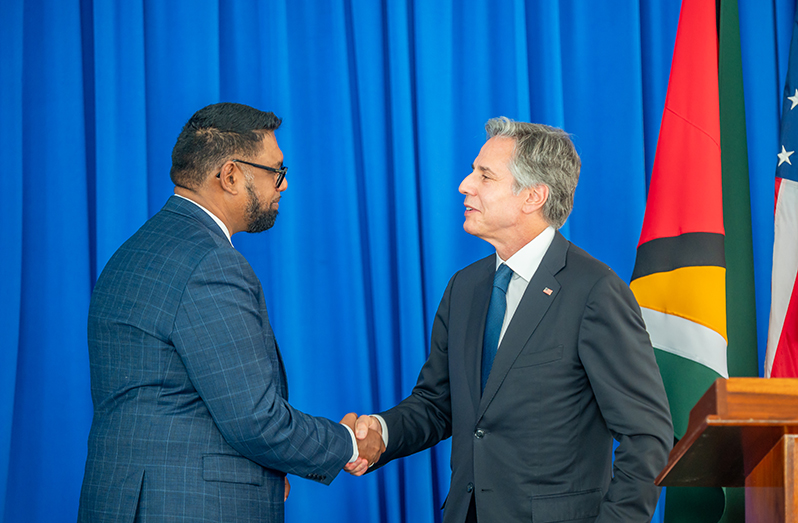GUYANA’S dedication to preserving its forests and their role in stopping climate change is highly significant. During a recent meeting, President Dr. Mohamed Irfaan Ali informed US Secretary of State Antony Blinken about Guyana’s environmental initiatives, including efforts to protect forests and potential collaborations to address climate change.
President Ali emphasized a historic agreement in which Guyana will receive at least $750 million from the sale of globally certified carbon credits to the Hess Corporation over the course of the following 10 years, with at least 15% of the proceeds being allocated to indigenous communities. “The agreement that Guyana reached with a private corporation… is of great significance and demonstrates in a very powerful way how Guyana is all at once, using responsibly, the funding resources that it now has at hand, while also making investments in the climate future and making investments in the transition to renewables,” Dr. Ali said.
In his remarks, Secretary Blinken praised Guyana for being a pioneer in the preservation of forests and for serving as an example of how responsible fossil-fuel use can coexist with climate mitigation and environmental protection.
He also agreed that Guyana is a crucial national carbon sink because 86 percent of its land is covered with trees. Through the Export-Import Bank, the Secretary of State said that the United States is actively working with the Guyana government on a significant gas-to-energy project that aims to reduce emissions by half, while utilizing American knowledge to support Guyana’s rapid economic development and improve regional energy security.
The leaders also emphasized the significance of food security, particularly in the Caribbean area, which has faced tough challenges because of the continuous hostilities the COVID-19 pandemic, and global climate issues.
Both nations reaffirmed their commitment to addressing these challenges and noted ongoing co-operation through programmes such as the US-Caribbean High-Level Action Committee on Food Security.
In order to increase food security in the area, Guyana has been at the forefront of initiatives to increase small farmers’ access to technology, lower trade barriers, and upgrade transportation infrastructure.

In keeping with its commitment to promote growth and prosperity in Indigenous villages, Guyana has already allocated $1.3 billion in carbon-credit funds from the $4.7 billion for indigenous villages, received from Hess Corporation from the sale of 30% of the country’s forests. During a recent Regional Toshaos/CDC Chairpersons Conference 2023 for Region One (Barima-Waini), which was sponsored by the Regional Democratic Council (RDC), the Minister of Amerindian Affairs, Pauline Sukhai, revealed the information.
The minister also disclosed that 37 communities in the Barima-Waini region have already withdrawn the funds deposited into their bank accounts.
According to her, “There’s no problem with finances… When I visit villages, I expect to see a hive of activities, new and spanking infrastructure being worked on, and engaging communities and villages. “I would like to see women’s projects on the rise; I would like to see projects relating to young people, youth, and sports development; I would like to see that you are paying attention to the elderly.”
The Village Sustainability Plans (VSPs) for 197 of the 242 Amerindian villages in Guyana have been submitted, enabling those communities to use the funds that are available in their bank accounts. The minister also advised leaders to complete their projects on time so that villagers can benefit when more funding is made available to indigenous settlements. These include the Amerindian Development Fund (ADF), the Presidential Grant Programme, the $10 million COVID-19 investment fund and the $3 billion supplemental budget for Amerindian development that was designated in the last National Toshaos’ Conference (NTC).
Minister Sukhai encouraged villages to submit their budgets to the ministry in order to be eligible for funds from the $3 billion supplemental fund. She also urged the Amerindian leaders to uphold accountability and serve in the best interests of the people and the villages.
Developing low-carbon opportunities all across Guyana, is a major focus of LCDS 2030.
Guyana’s Low Carbon Development Strategy 2030 outlines the approach and action that Guyana, as a nation, can take to develop and grow for the inclusive benefit of all in a non-polluting, low-carbon way. It involves utilising Guyana’s natural resources in a sustainable manner while combatting climate change and its adverse effects such as floods and droughts. The strategy has a global ambition to show how Guyana can sustain its world-class ecosystem services for the long term by integrating with the global economy and receiving payments for ecosystem services – payments which then go to transforming village economies and fostering national development. LCDS 2030 aligns with and contributes to global climate goals, including net zero carbon emissions and keeping global temperatures below 1.5˚C.
(This is part of a weekly series on LCDS.) The author can be contacted at cparkinson0206@gmail.com.



.jpg)








